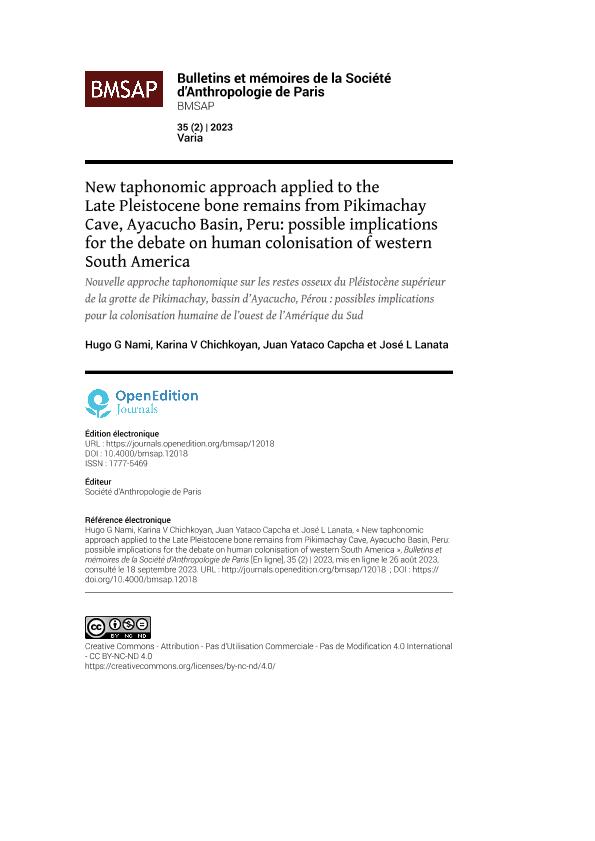Artículo
La grotte de Pikimachay dans le sud-est du Pérou a joué un rôle important dans les discussions concernant le premier peuplement de l’archéologie sud-américaine, et en particulier dans les Andes du Sud. Les fouilles effectuées par Richard MacNeish en 1969-1970 ont permis l’identification d’une séquence d’occupations humaines possibles et controversées du Pléistocène tardif aux temps historiques. Dans le cadre d’un programme de recherche visant à réévaluer les vestiges du Pléistocène supérieur de ce site, nous avons effectué des observations taphonomiques sur un échantillon osseux (n=40) appartenant à ses strates inférieures (couches h à k) comme suit : h (n=17), h1 (n=6), i (n=4), i1 (n=7), j (n=5) et k (n=1). Les datations au radiocarbone conventionnelles non calibrées initialement obtenues suggèrent que ces couches couvrent une période d’environ 14 à 25000 ans avant le présent (kybp). Chaque os a été minutieusement étudié pour connaître la nature de ses modifications, décrire l’état général des spécimens et les altérations, dans le but d’identifier une éventuelle intervention anthropique. À cette fin, nous avons considéré les modifications de surface enregistrant des fractures fraîches et post-dépositionnelles, différents types de marques, l’altération et la présence de taches de manganèse. Nous avons conclu que divers os (n=8) de la couche h étaient affectés par diverses modifications d’origine humaine. On peut donc supposer que ces nouvelles informations justifient l’hypothèse selon laquelle les os et les matériaux lithiques de la couche h auraient été produits au cours de l’Holocène inférieur/Pléistocène terminal entre ~≥9,0/10,0 et ~14,1, probablement à ~14,1 kybp ; un fait qui peut être considéré pour les restes de pierre des strates sous-jacentes h1 qui ont donné une date similaire. Les restes osseux des strates j à k ne présentent pas de modifications humaines. Ensuite, si la chronologie rapportée et son association avec les restes anthropiques sont vraies, Pikimachay pourrait encore être pertinent en ce qui concerne la discussion sur la question de la colonisation humaine dans l’ouest de l’Amérique du Sud à une époque acceptable pendant la période postglaciaire. The Pikimachay cave in south-eastern Peru had an important role in archaeological discussions concerning the first peopling of South America, and the Southern Andes in particular. The excavations by Richard MacNeish in 1969-1970 identified a sequence of possible but controversial Late Pleistocene human occupations up to historical times. As a part of a research programme aiming to re-assess the Late Pleistocene remains from this site, we made taphonomic observations on a sample of bones (n=40) from the lower strata (layers h to k) as follows: h (n=17), h1 (n=6), i (n=4), i1 (n=7), j (n=5), and k (n=1). The conventional uncalibrated radiocarbon dates initially obtained suggest that these layers span a period of ~14.0 to 25.0 thousand years before present (kybp). Each bone was thoroughly examined to determine the nature of modifications to them, and to describe alterations and the general condition of the specimens in order to identify possible anthropic intervention. For this purpose, we examined the surface modifications indicating fresh or post-depositional fractures, the different kinds of marks, weathering, and the presence of manganese staining. We concluded that several bones (n=8) from layer h showed various human-made modifications. We can therefore suggest that this new information justifies the assumption that the bones and lithic materials from layer h would have been produced during the Early Holocene/Late Pleistocene between ~≥9.0/10.0 and ~14.1, probably at ~14.1 kybp; an assumption that can also be considered for the stone remains from the underlying strata h1 that yielded a similar date. The bone remains from strata j to k do not show any human modifications. Furthermore, if the reported chronology and its association with the anthropic remains are true, the Pikimachay cave could still be relevant to the debate over the human colonisation of western South America that occurred within a similar timeframe during the postglacial era.
New taphonomic approach applied to the Late Pleistocene bone remains from Pikimachay Cave, Ayacucho Basin, Peru: Possible implications for the debate on human colonisation of western South America
Título:
Nouvelle approche taphonomique sur les restes osseux du Pléistocène supérieur de la grotte de Pikimachay, bassin d’Ayacucho, Pérou: Possibles implications pour la colonisation humaine de l’ouest de l’Amérique du Sud
Fecha de publicación:
08/2023
Editorial:
Société d' Anthropologie de Paris
Revista:
Bulletins et mémories de la Société d' Anthropologie de Paris
ISSN:
1777-5469
Idioma:
Inglés
Tipo de recurso:
Artículo publicado
Clasificación temática:
Resumen
Palabras clave:
ARCHAEOLOGY
,
PALEONTOLOGY
,
TAPHONOMY
,
HUMAN COLONISATION
Archivos asociados
Licencia
Identificadores
Colecciones
Articulos(IGEBA)
Articulos de INSTITUTO DE GEOCIENCIAS BASICAS, APLICADAS Y AMBIENTALES DE BS. AS
Articulos de INSTITUTO DE GEOCIENCIAS BASICAS, APLICADAS Y AMBIENTALES DE BS. AS
Articulos(IIDYPCA)
Articulos de INST. DE INVESTIGACIONES EN DIVERSIDAD CULTURAL Y PROCESOS DE CAMBIO
Articulos de INST. DE INVESTIGACIONES EN DIVERSIDAD CULTURAL Y PROCESOS DE CAMBIO
Articulos(SEDE CENTRAL)
Articulos de SEDE CENTRAL
Articulos de SEDE CENTRAL
Citación
Nami, Hugo Gabriel; Chichkoyan, Karina Vanesa; Chichkoyan, Karina Vanesa; Lanata, Jose Luis; New taphonomic approach applied to the Late Pleistocene bone remains from Pikimachay Cave, Ayacucho Basin, Peru: Possible implications for the debate on human colonisation of western South America; Société d' Anthropologie de Paris; Bulletins et mémories de la Société d' Anthropologie de Paris; 35; 2; 8-2023; 1-22
Compartir
Altmétricas




